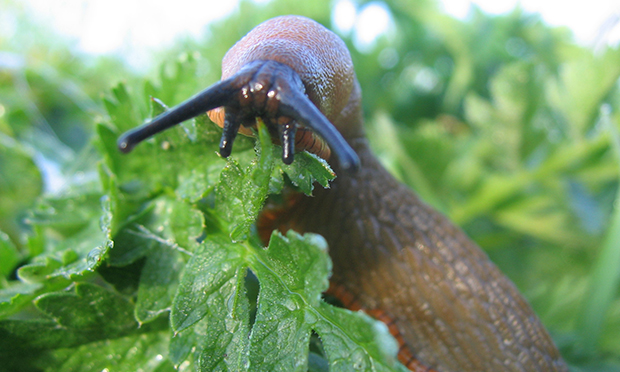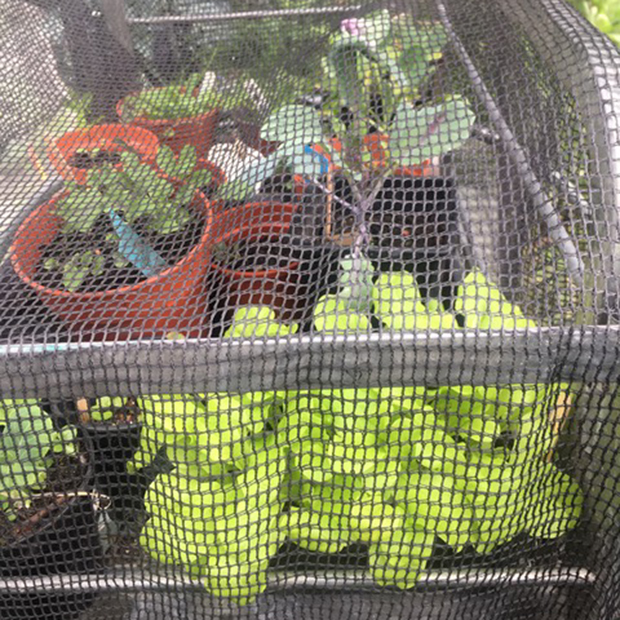The Citizen Gardener: Summer slug fest

If it’s not one thing, it’s another. Summer has brought both flood and heatwaves and both bring problems for the gardener.
This summer has been an awful or great one for slugs and snails (depending on your point of view). The wet weather suits them very nicely. It keeps flying insects from getting about but slugs just love it and they’ve been multiplying – and feeding.
In Victoria Park we’re trying to raise leafy greens to donate to a local organisation but everything recently got razed to the ground – including quite well-established beans and cucumbers – so I’ve been thinking about slugs and snails a lot recently and remembering what I’d forgotten – like don’t plant your seedlings out too early.
Here are a few things I’ve learned about slugs.
There are about 40 varieties of slugs in the UK but not all of them will actually eat your tender veg; in fact many only eat fungi, lichens or rotting matter so help clear waste and produce compost. Others, like the leopard slug is a carnivore (unlike most slugs) and have been known to predate other slugs.
The grey field slug (deroceras reticulatum) and southern garden slugs (arion hortensis) are the two which do the damage. We’ve noticed in Victoria Park that they don’t seem to like red things as much as green things, so red curly kale, red lettuce, perilla and purple basil for example do better than their green cousins. They are less likely to eat perennial vegetables, like kale, probably because slugs only eat very tender leaves. They have about 100,000 teeth but can’t or won’t eat tough, hairy leaves or stalks. They provide food for frogs, beetles, hedgehogs and birds so if you can make space for those, you can reduce your population of slugs.
‘There’s a bit of a myth about not watering when it’s sunny’
Barriers can reduce damage – grit, water, copper tape, bottle cloches (water bottles cut off and placed over your young plants), wool pellets and netting can all help. People also use beer traps, which are effective but also drown beneficial insects.
Raised beds can help – but the slimy ones will get there eventually and if they are lined with plastic, will hide there.
Big slugs often do less damage than the smaller ones. Some live underground so you never see the damage they do until you dig up your potatoes. Nematodes can kill them – but they will come back.
Sow seeds into trays or pots and wait till the plant is mature before planting out. Never use pellets. Even the ferric phosphate rather than metaldehyde-based ones are damaging to earthworms and frogs.

Sometimes it’s the weather and conditions that are the problem rather than the slug. If, like on my plot, there are lots of hiding places for them which are damp and dark, they don’t have far to dash towards your seedlings. If you clear lots of space around your plants, they will be a bit safer. Plant about 30 per cent more than you think you’ll need – that’s about the amount that you will lose so be prepared to sacrifice some of your plants to nature.
Considering how many slugs and snails you find in your garden, they don’t do as much damage as you think.
When the sun is out, the slugs and snails retreat. But then your plants are facing other problems like dehydration. Most plants can cope if they have a good root system and are well-mulched.
There is a bit of a myth about not watering when it’s sunny to avoid burning the plants but this happens naturally so it shouldn’t be a problem. It is best to water when it’s cooler, though – mainly to avoid evaporation and it’s important not to do any cultivation (sowing, transplanting, fertilizing et cetera) in hot weather as small plants that don’t have an established root system will not survive.
For those plants that need a bit of shade, like leafy veg, you can provide cover for them. I put netting over my lettuce (which doesn’t like too much sun). Old net curtains would do. But if your soil is good with lots of organic matter in it, it will retain a lot of moisture and if you mulch after a big water, that too will keep water in as more water is lost through evaporation than drainage (one of the reasons why it’s not good to have bare soil).
But plants have their own ways of coping with the heat. Many curl up their leaves or droop, like pumpkins, and recover when it gets cooler. Others drop their flowers, or just don’t produce as much fruit.
‘We will have to adapt more to deal with climate change’
Unpredictable weather – and extremes – have always been difficult enough for the gardener and farmer, but we are going to have to adapt more to deal with climate change. We’re getting milder, wetter winters and hotter summers and more extreme weather events. Because of the milder weather we will meet new pests and diseases, and high temperatures mean plants are less able to withstand attacks.
An RHS report suggests that gardeners can take advantage of the warmer winters by growing more tender plants while relying less on traditional veg like carrots and onions which will yield less.
It is likely that London won’t experience frosts in the future and I’ve already heard of people growing pineapples!
The more violent rain can wash away nutrients and cause soil erosion so we need to put lots of organic matter in our soil so it’s better at holding onto the water and nutrients.
Water shortages in future summers means we need to start thinking about how to collect, store and retain it better. We can create bigger water storage areas (I have a 1,000-litre tank which fills from my shed) and build rain gardens to slow down water and help it sink into the soil rather than go into the drains to reduce flooding.
Some farmers are introducing reservoirs on their land and growing varieties of vegetables that are more tolerant of drought. Others are not using soil at all, like Growing Underground, which, 30 metres under Clapham, is raising salad leaves using hydroponics and LED lighting.
I’m a lover of soil, so it will take a while to be converted to these new-fangled ways, but it may come.
Kate Poland is an award-winning community gardener and the UK’s first ever postcode gardener in E5. For more, head to cordwainersgrow.org.uk and friendsoftheearth.uk.
